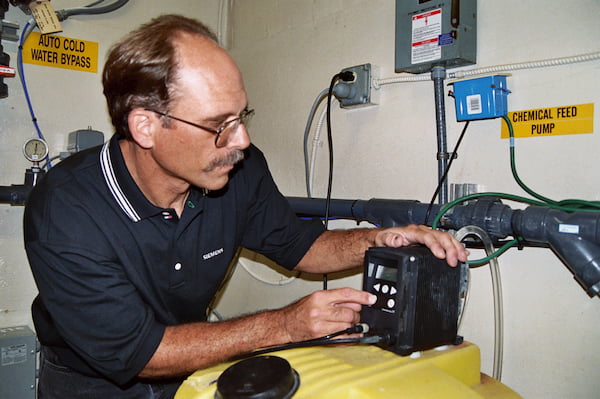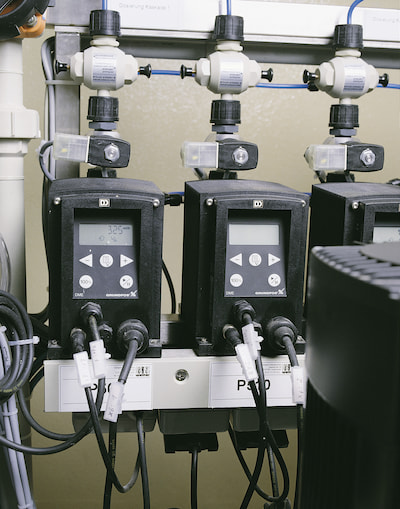New digital dosing technology is redefining the expectations of water and wastewater utilities.
Metering pumps, also called dosing pumps, are found in virtually every facet of water and wastewater treatment, municipal and industrial.
Metering pump users are witnessing the introduction of a significantly new design platform that improves accuracy, control, and costs, while simplifying operation. The robotic premise of these advanced metering pumps creates nearly limitless potential for new user benefits.
The Progression Towards Digital Dosing
Late 1930s: Milton Sheen and son Robert of Betz Laboratories develop the first commercial metering pump. The Sheens added easily serviceable check valves (step valves) to the pump head.
1940s: Dosing pumps first produced commercially as chemical feed pumps.
1940s and 1950s: Modifications to the mechanical adjustment of the stroke length.
Late 1950s and early 1960s: Diaphragm added to dosing pumps. The diaphragm eliminated the need for the plunger to be exposed to the chemical being pumped, making the pump sealless. Mechanically and hydraulically actuated versions available.
1970s: Solenoid drive, which made metering pumps less complicated and considerably more affordable, introduced. Solenoid Drive design still used a diaphragm, but the diaphragm was actuated by energizing and de-energizing a solenoid.
1980s: Constant speed synchronous AC motor and a mechanically actuated design concept becomes alternative to solenoid. Incorporated electronic controls could have power to pump turned on or off, accept a pulse signal, or accept a 4-mA to 20-mA signal to cause the pump to turn on or off.
1990s: Manufacturers begin to incorporate variable frequency drives, stepper motors, and servo motors into metering pump designs.
2000s: State-of-the-art stepper or brushless DC motors, in combination with software to vastly improve the intelligence of the electronic control, developed to allow digital dosing pumps to always operate at full stroke length.
By definition, metering or dosing pumps are positive displacement pumps that incorporate an internal means of adjusting capacity and inject accurately controlled volumes of liquid. Metering pumps began as rudimentary machines that incorporated crude mechanical adjustments to control capacity. Flow-rate confirmation and pulsation dampening have been supplied as external accessories, often more than doubling the cost of a metering installation. Innovation has been focused on improving capacity control, reducing leakage, and handling difficult liquids.

Richard Faulkner of Siemens with a Grundfos dosing pump.
After decades of design changes, this convenient form of chemical injection is evolving into the instrument that pioneers of metering pumps foresaw: a level of intelligence within the pump, where flow inducement is less a part of design advancement and more a matter of controlling and measuring the amount dispensed.
Highlighted below are case studies involving digital dosing technology and its benefits at four water and wastewater utilities.
Salt Lake City Public Utilities
Metering pumps found in water and wastewater treatment (alongside cooling towers and boilers), commercial and municipal swimming pools, and in virtually every manufacturing plant are usually injecting expensive additives. The ability of these pumps to meter precisely and conveniently is critical.
Like most public utilities, the Salt Lake City Public Utilities (SLCPU) wants to ensure that new technology provides measurable benefits before it makes wholesale conversions. The Water plant manager for SLCPU, Ken Hibbert, is satisfied that the digital dosing pump they have evaluated over the past two years has proven to be superior to the solenoid pumps used in the past.
SLCPU plans to convert other metering applications to this new technology. The water utility originally purchased a digital dosing pump as a back-up metering pump, allowing them to take older solenoid pumps out of service for maintenance. They could also “test drive” the digital dosing pump in a variety of metering applications.
The first pleasant surprise for the utility was that they were able to use the same pump, with no material changes, to handle several polymers, sodium hypochlorite, caustic soda, and ferric chloride. Secondly, the inherent variable speed capability in the new pump permits viscous products to be more completely drawn into the pumping chamber than the fast moving diaphragms on SLCPU’s solenoid metering pumps.
Hibbert is most excited about the high turndown ratio (accurate capacity range) of the digital dosing pump.
With the huge variation of stream flow and turbidity with which the water utility deals throughout the year, their need for treatment chemicals varies widely. Consequently, in the past, they have required two different sizes of solenoid metering pumps to meet their treatment chemical flow range. The 800:1 turndown ratio of the new digital dosing pump allows this to be done with a single pump. The same pump can even be used to replace the much larger and more expensive roto dip feeders that SLCPU has used for high turndown chemical feed applications.
Fresno Water Department
The City of Fresno, CA, Water Department installed 40 digital metering pumps in chlorine injection service at some of their wells roughly two years ago, and an additional two pumps in fluoride injection. The utility also has more than 200 older style metering pumps of various brands installed.
According to Dennis Hall, Water Systems Operator II, digital dosing pumps are extremely simple to use. The stepper motors provide even flow with no pulsations, a big change from the high pulsations of their older metering pumps. Hall commented that setting the flow rate directly, without having to deal with stroke adjustment, greatly simplifies the setup for these pumps, and results in reaching the desired residuals much quicker.
He also commented that calibration of the digital dosing pump is faster and easier, and can be done with the pump working against no pressure, or against full system pressure, with equal accuracy. Hall also remarked on the wide flow capability range of the pumps and their ability to meter off gassing liquids quite well. Lastly, he mentioned that in the two years since the pumps were installed, only two have come in for repair, and these may have been dropped during handling.
Using state-of-the-art motor technologies, in combination with advanced software to vastly improve electronic control, new digital dosing pumps avoid the frustrating hydraulic complications that impact accuracy and dependability when capacity is changed by adjusting the travel of the diaphragm, the stroke length.
The new technology provides an even greater range of capacity adjustment (e.g. 1000:1) without compromising accuracy. Noise, shaking and stress on piping and accessories are all drastically reduced, as digital dosing provides the least pressure spike of any metering pump to date.
The speed of both discharge and suction stroke can be varied independently, such that the discharge stroke can be adjusted to last over 25 seconds for dosing in critical low flow applications, affording very smooth chemical injection. Such precise stroke control facilitates easier priming and permits improved handling of difficult applications.
Milford, CT
The City of Milford closely monitors the wastewater from biotech manufacturer Avecia. According to facilities manager Tony Manzello, they installed four digital dosing pumps in pH neutralization service one year ago, two each handling sodium hydroxide and 20 percent hydrochloric acid. For the ten years prior to this, solenoid metering pumps have been used in this service at Avecia.
The payback for the switch to digital dosing technology came almost immediately, in the form of a significant reduction of neutralizing chemicals used in the wastewater treatment. The improved accuracy and control of the digital dosing pumps paid for themselves in the first three months, based on chemical savings. In the past year, the calibration of the digital dosing pumps (checked monthly by an independent contractor) hasn’t changed, while the solenoid pumps constantly required recalibrating.
Digital dosing eliminates the practice of operating pumps at something less than 100 percent of stroke length to control capacity. Any capacity selected is dosed with the same length of diaphragm travel; only the speed of travel changes. Beyond the elimination of capacity control knobs, the precise control of diaphragm travel translates into accurate yet broader capacity adjustment capability.
Collectively these features reduce complexity, while cost effectively improving this new technology’s ability to fulfill user expectations.
Collier County Water, FL
Collier County Water has found the main benefits of their digital dosing pumps to be simplicity of use, reliability, and accuracy. The water utility has four of these pumps metering scale inhibitor and phosphate in their North Regional Water Treatment Plant, according to senior operator Barry Erickson and plant mechanic Brian Bower.

Digital Dosing Pump Control Panel
They find changing feed rates on the pumps to be very simple, requiring only an adjustment of the digital readout on the pump control panel (no need to balance stroke length adjustment against stroke frequency change). A spot check of the flow rate using drawdown tubes invariably finds that changes in flow are accurate, that the pump is doing exactly what they have set it to do. Everyone in the plant that works with the pumps is quite pleased with the digital dosing performance.
What’s Next for Digital Dosing Pumps?
Key innovations being incorporated into this newest metering pump technology include the ability to directly monitor dosing-head conditions like pressure and flow, and then process these outputs in conjunction with motor readings on a continuous basis.
This allows users with applications like ultra filtration and reverse osmosis to closely track performance and condition of the pump and its system. Some of these new digital dosing pumps can already self-compensate based on changes in the variables being monitored.
Combining dosing, measuring, and regulating into one machine means that the user isn’t required to make traditional arithmetic calculations to set the pump’s flow. They simply input desired injection rates. The pump delivers the flow rate set, without the need for independent flow measurement that historically costs more than the metering pump.
This new digital dosing opens up a whole new world of possibilities. Tomorrow’s metering pumps will function like robots. One wireless instrument will seamlessly monitor, troubleshoot, perform diagnostics, and appropriately adjust operation to conform to application changes and control variables.
Digital dosing will eliminate system dependency on accessories such as flow meters, pressure relief valves, calibration columns, and pulsation dampeners. Metering pumps of this new design platform will reset “user-friendly” expectations. Finally, the costs of metering installations will decline as the value in digital dosing pumps advances and makes the metering pumps complete dosing solutions.
Pumps & Systems, October 2006

